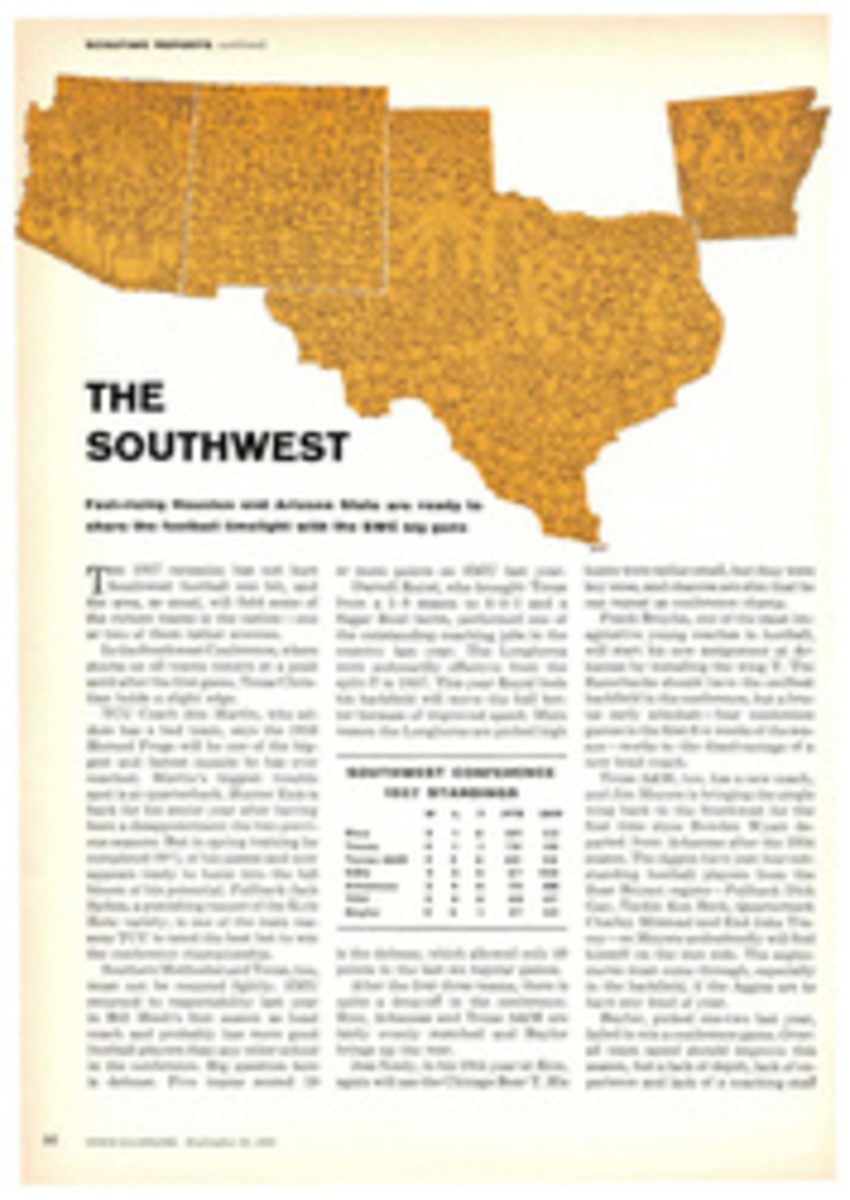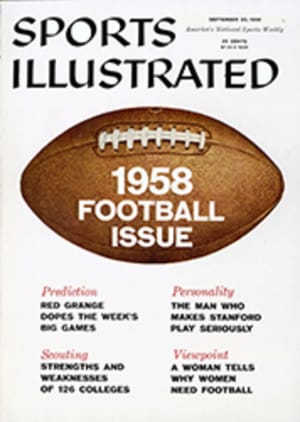
LOU GROZA TEACHES YOU THE PLACE KICK
It might come under the heading of irony to note that when the College All-Stars beat Detroit in August they used one of the pros' favorite weapons, the field goal, to do it. Bobby Joe Conrad kicked four field goals, equaling my best record for a single game. Maybe it's more important to point out that Conrad's performance may be a sign of the importance the kicker has assumed in college football because of the new rule for points after touchdown. If a team doesn't have a place-kicking threat, the opponent can spread its defenses on the goal line and make it that much more difficult to run or pass for the two-point conversion; with the kicking threat you are sure of one point, and the two points will be easier since the opposition will have to put pressure on your kicker. Also, a three-point field goal will come in handy in erasing a two-point conversion edge.
Now more than ever it would be worthwhile for a youngster to master the art of place-kicking. On the following pages I tell about the things I have learned through the years, things it took me a long while to perfect but which any young man can learn if he will practice. Successful place-kicking is largely a matter of timing, and you get the timing only if you're willing to spend plenty of time practicing. Maybe it's corny to say the foot is back in college football, but, believe me, it is.
Placing the ball
I will start first with the kickoff, because all the basic movements of place-kicking are involved in it, and in kicking field goals you simply modify to fit the situation. On the kickoff I use a kicking tee. I set the ball straight up and down, so it won't fall forward or get blown off. If I tilted the ball, too, I'd get lots of loft but not nearly the distance I want. Under exceptional wind conditions I may alter this rule, tilting the ball back to take advantage of a strong following wind. If there is a strong head wind, my safety man holds the ball for me, tilting it slightly forward to get a lower, wind-boring trajectory. Crosswinds don't worry me much. I may even take advantage of one now and then by kicking toward a corner and letting the ball tag along with the wind. One other thing. I make certain the laces face straight down the field. If they are cockeyed, you get uneven wind resistance and the ball will be carried off to one side.
Meeting the ball
At the moment of contact, I am not trying to kick the ball up in the air. What I am trying to do is to drive right through the spot on the ball I'm aiming at, drive through it parallel to the ground. The point of impact is right on the seam of the ball, just below the center. My right ankle locks an instant before impact with the ball, the knee locks immediately after, and I try to kick right through the ball as far as I can. At impact, my hands are coming forward, my eyes are on the spot on the ball I want to hit and I'm still leaning forward. I take a skip step with my left foot after the ball is away, because of the momentum of the kick. The forward lean gives me more of a sensation of kicking through the ball and adds to the power of the kick at the important moment when I have made contact.
The equipment
For a kicker I advise a very snug-fitting pair of football shoes. My own are size 11, one size smaller than my street shoes. The snugness gives me a better feel of the ball; for the same reason, I don't wear a heavy pair of sweat socks but a single thin pair. Most everyone uses the square kicking toe; it's harder and, being flat across the front, it allows you a slight margin for error if the ball is not placed right or if you don't kick squarely.
The onside kick
Fairly often, in both college and professional football, you'll see the onside kick when a team wants to retain possession of the ball after scoring. A kickoff is a free ball beyond mid-field, or 10 yards beyond the kicking point. The object of the onside kick is to get the ball just over that 10-yard distance, so that your team can recover it and put you on the offense on about the 50-yard line. For this kick I set the ball on the tee exactly as I do for a regular kickoff. The only difference is that I hold back on the swing of my right leg. I tap the ball; not just below the center, as I normally would, but in the upper third, on the side. If it's kicked properly it hits the ground quickly, takes a very high bounce and it's a free ball by the time it comes down, just over the 50-yard line. You'll have to work at this to find out just how hard to tap the ball when you kick it so that it will go far enough down field and take a high enough bounce to give your teammates time to get down there and make a recovery.
The approach and follow-through
The point at which different kickers take their initial stance may vary considerably. You have to work out a spot from which you can build up good speed without tiring yourself. For me this is 10 yards behind the ball. I stand directly behind the ball unless I plan to kick away from some dangerous runner-like Ollie Matson. In that case I take a step to the left or right but stay on the 30, my right foot on the line, the left back a little, toe to instep. I relax, standing easily on the balls of my feet, arms swinging loosely in front of me. I drive hard off my left foot, reaching three-quarter speed in a couple of steps. I don't go faster until after the kick; I have better control and a fraction more time in case I have to adjust for some error. A half yard from the ball, I begin my kick. I am on my left foot. My right leg is back and just beginning to swing down. It becomes a pendulum. I have a feeling it is being thrown downward through an arc. At this point it is very important to lock your right ankle upward, toes up. I am bent forward to give myself better balance and added straight-ahead impetus. A split second after contact, my right knee locks. When I land on my right foot, the kick is over and I start looking for blockers.
Kicking the field goal
In pro football we are not allowed to use a kicking tee for field goals or extra points as you can in school and college football. For this reason, I try to mark a spot for my holder by scratching a line with my cleats or by pulling out a tuft of grass, to give myself an exact point of contact for the kick. Not having time for a 10-yard run at the ball, as in the kickoff, I have to pick up all my momentum in about two and a half yards. First, I take two and a half normal walking strides from where the ball will be placed down and assume my stance there. This stance is the same as in the kickoff, but I take much more care in lining myself up. I start my approach to the kick as soon as the pass from the center hits my holder's hands, beginning with a short, rolling step (from heel to toe) with my right foot. Then I take a long, lunging step, landing on my left foot, the pendulum action starting in my right leg as I land. My ankle locks, swings down and forward, my left foot is flat on the ground and I am leaning over the ball as I make contact. The force of the follow-through causes me to take a skipping step on my left foot. I usually kick from about seven yards back of the line of scrimmage to take advantage of the pocket formed by my blockers. If I moved farther back, I would give the outside rushers a better rushing angle; up closer, the inside linemen and backers, who block most kicks, would have a shorter route. Incidentally, I make every field goal or extra point kick an all-out effort, regardless of the distance involved. You can't groove the swing of your leg if you ease up on the force of the kick for the shorter attempts.
READY FOR THE SNAP: Here I am in a balanced position, completely relaxed, concentrating on the spot where the ball will be placed down. My right foot is slightly forward, and my arms swing in a relaxed arc. I'll move as ball hits the holder.
THE APPROACH: The holder has placed the ball on the ground as I begin my second and long step. Here is where he will rotate the ball to get laces in front if he has time. I am still concentrating on the kicking point, keeping my eyes on the ball.
ACCURACY IS PARAMOUNT: When I set myself for a field goal attempt, I line up my shoulders with the tops of the goal posts (left). That is true even on severe angle kicks, too; while I may be at an angle to the line of scrimmage, I am still kicking straight between the goal posts, although the target, naturally, has become much smaller. If the holder places the ball down with the laces toward me by mistake, I try to kick under the laces; hitting them spoils your accuracy, especially on very long kicks.
THE START: Now the ball has reached the holder's hands, and he is preparing to place it down on the spot I have marked, laces away if possible. I lead off with my right foot, taking a short, rolling step, still concentrating on where the ball will be.
THE CONTACT: As the holder sets ball firmly with one finger, I land on my left foot, cocking my right leg. The right leg swings like a pendulum, the ankle locks before impact, knee immediately after. A powerful follow-through gets distance.
EIGHT ILLUSTRATIONS
ROBERT RIGER
ILLUSTRATION
ROBERT RIGER
1
ILLUSTRATION
ROBERT RIGER
2
ILLUSTRATION
ROBERT RIGER
3
ILLUSTRATION
ROBERT RIGER
4
ILLUSTRATION
ROBERT RIGER
5
ILLUSTRATION
ROBERT RIGER
6

